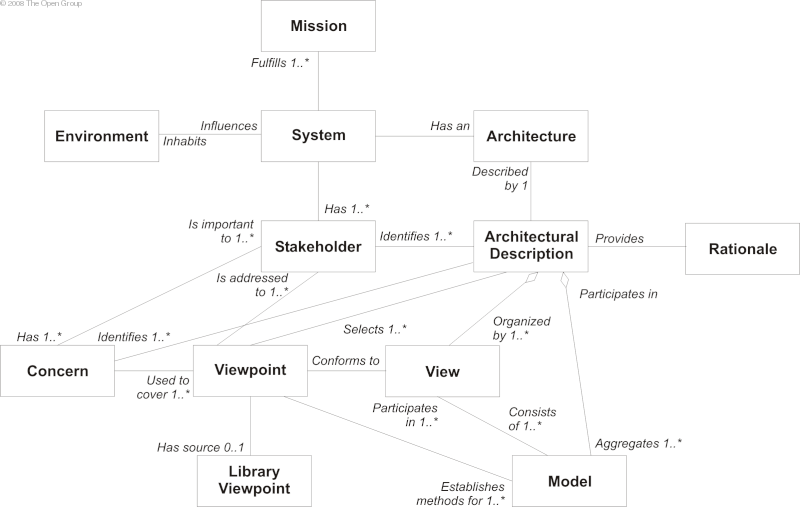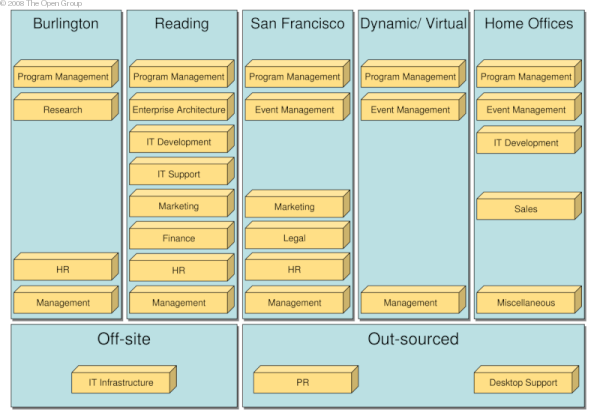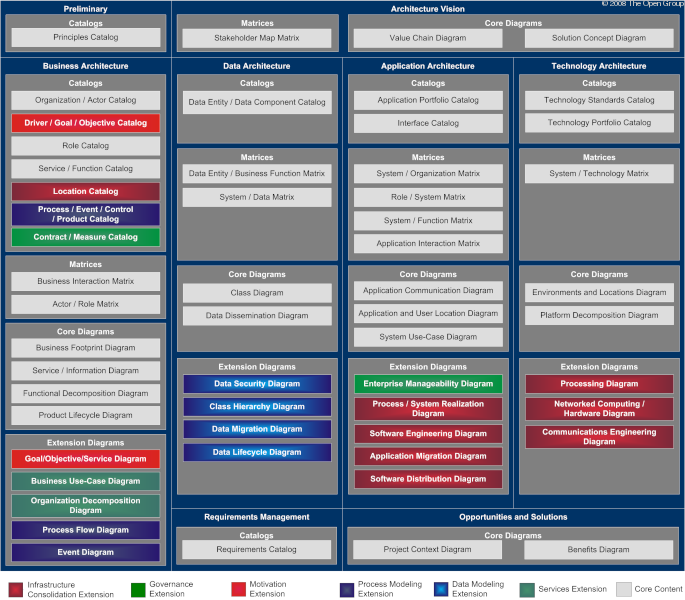| Overview of Artifacts and Viewpoints | |
|
|
This chapter describes a set of atomic work products that are created when developing an architecture. An artifact represents an individual model of a system or solution, which could potentially be re-used in a variety of contexts. An artifact is distinct from a deliverable, which is a contracted output from a project. In general cases, deliverables will contain artifacts and each artifact may exist in many deliverables. This chapter discusses the concepts surrounding architecture artifacts and then goes on to discuss the artifacts that are created at each phase within the Architecture Development Method (ADM). Basic Concepts
Architectural artifacts are created in order to describe a system, solution, or state of the enterprise. The concepts
discussed in this section have been adapted from more formal definitions contained in ISO/IEC 42010:2007 and
illustrated in Basic
Architectural Concepts .

A "system" is a collection of components organized to accomplish a specific function or set of functions. The "architecture" of a system is the system's fundamental organization, embodied in its components, their relationships to each other and to the environment, and the principles guiding its design and evolution. An "architecture description" is a collection of artifacts that document an architecture. In TOGAF, architecture views are the key artifacts in an architecture description. "Stakeholders" are people who have key roles in, or concerns about, the system; for example, as users, developers, or managers. Different stakeholders with different roles in the system will have different concerns. Stakeholders can be individuals, teams, or organizations (or classes thereof). "Concerns" are the key interests that are crucially important to the stakeholders in the system, and determine the acceptability of the system. Concerns may pertain to any aspect of the system's functioning, development, or operation, including considerations such as performance, reliability, security, distribution, and evolvability. A "view" is a representation of a whole system from the perspective of a related set of concerns. In capturing or representing the design of a system architecture, the architect will typically create one or more architecture models, possibly using different tools. A view will comprise selected parts of one or more models, chosen so as to demonstrate to a particular stakeholder or group of stakeholders that their concerns are being adequately addressed in the design of the system architecture. A "viewpoint" defines the perspective from which a view is taken. More specifically, a viewpoint defines: how to construct and use a view (by means of an appropriate schema or template); the information that should appear in the view; the modeling techniques for expressing and analyzing the information; and a rationale for these choices (e.g., by describing the purpose and intended audience of the view).
In summary, then, architecture views are representations of the overall architecture in terms meaningful to
stakeholders. They enable the architecture to be communicated to and understood by the stakeholders, so they can verify
that the system will address their concerns.
Simple Example of a Viewpoint and ViewFor many architectures, a useful viewpoint is that of business domains, which can be illustrated by an example from The Open Group itself. The viewpoint is specified as follows:
The corresponding view of The Open Group (in 2008) is shown in Example View - The Open Group Business Domains in 2008 . 
Developing Views in the ADMGeneral GuidelinesThe choice of which particular architecture views to develop is one of the key decisions that the architect has to make. The architect has a responsibility for ensuring the completeness (fitness-for-purpose) of the architecture, in terms of adequately addressing all the pertinent concerns of its stakeholders; and the integrity of the architecture, in terms of connecting all the various views to each other, satisfactorily reconciling the conflicting concerns of different stakeholders, and showing the trade-offs made in so doing (as between security and performance, for example). The choice has to be constrained by considerations of practicality, and by the principle of fitness-for-purpose (i.e., the architecture should be developed only to the point at which it is fit-for-purpose, and not reiterated ad infinitum as an academic exercise). As explained in Part II: Architecture Development Method (ADM), the development of architecture views is an iterative process. The typical progression is from business to technology, using a technique such as business scenarios (see Part III, Business Scenarios) to properly identify all pertinent concerns; and from high-level overview to lower-level detail, continually referring back to the concerns and requirements of the stakeholders throughout the process. Moreover, each of these progressions has to be made for two distinct environments: the existing environment (referred to as the baseline in the ADM) and the target environment. The architect must develop pertinent architecture views of both the Baseline Architecture and the Target Architecture. This provides the context for the gap analysis at the end of Phases B, C, and D of the ADM, which establishes the elements of the Baseline Architecture to be carried forward and the elements to be added, removed, or replaced. This whole process is explained in Part III, Gap Analysis . View Creation ProcessAs mentioned above, at the present time TOGAF encourages but does not mandate the use of ISO/IEC 42010:2007. The following description therefore covers both the situation where ISO/IEC 42010:2007 has been adopted and where it has not. ISO/IEC 42010:2007 itself does not require any specific process for developing viewpoints or creating views from them. Where ISO/IEC 42010:2007 has been adopted and become well-established practice within an organization, it will often be possible to create the required views for a particular architecture by following these steps:
This approach can be expected to bring the following benefits:
However, situations can always arise in which a view is needed for which no appropriate viewpoint has been predefined. This is also the situation, of course, when an organization has not yet incorporated ISO/IEC 42010:2007 into its architecture practice and established a library of viewpoints. In each case, the architect may choose to develop a new viewpoint that will cover the outstanding need, and then generate a view from it. (This is ISO/IEC 42010:2007 recommended practice.) Alternatively, a more pragmatic approach can be equally successful: the architect can create an ad hoc view for a specific system and later consider whether a generalized form of the implicit viewpoint should be defined explicitly and saved in a library, so that it can be re-used. (This is one way of establishing a library of viewpoints initially.) Whatever the context, the architect should be aware that every view has a viewpoint, at least implicitly, and that defining the viewpoint in a systematic way (as recommended by ISO/IEC 42010:2007) will help in assessing its effectiveness; i.e., does the viewpoint cover the relevant stakeholder concerns?. Views, Tools, and LanguagesThe need for architecture views, and the process of developing them following the ADM, are explained above. This section describes the relationships between architecture views, the tools used to develop and analyze them, and a standard language enabling interoperability between the tools. OverviewIn order to achieve the goals of completeness and integrity in an architecture, architecture views are usually developed, visualized, communicated, and managed using a tool. In the current state of the market, different tools normally have to be used to develop and analyze different views of the architecture. It is highly desirable that an architecture description be encoded in a standard language, to enable a standard approach to the description of architecture semantics and their re-use among different tools. A viewpoint is also normally developed, visualized, communicated, and managed using a tool, and it is also highly desirable that standard viewpoints (i.e., templates or schemas) be developed, so that different tools that deal in the same views can interoperate, the fundamental elements of an architecture can be re-used, and the architecture description can be shared among tools. Issues relating to the evaluation of tools for architecture work are discussed in detail in Part V, Tools for Architecture Development . Views and ViewpointsExample of Views and ViewpointsTo illustrate the concepts of views and viewpoints, consider the example of a very simple airport system with two different stakeholders: the pilot and the air traffic controller. One view can be developed from the viewpoint of the pilot, which addresses the pilot's concerns. Equally, another view can be developed from the viewpoint of the air traffic controller. Neither view completely describes the system in its entirety, because the viewpoint of each stakeholder constrains (and reduces) how each sees the overall system. The viewpoint of the pilot comprises some concerns that are not relevant to the controller, such as passengers and fuel, while the viewpoint of the controller comprises some concerns not relevant to the pilot, such as other planes. There are also elements shared between the two viewpoints, such as the communication model between the pilot and the controller, and the vital information about the plane itself. A viewpoint is a model (or description) of the information contained in a view. In our example, one viewpoint is the description of how the pilot sees the system, and the other viewpoint is how the controller sees the system. Pilots describe the system from their perspective, using a model of their position and vector toward or away from the runway. All pilots use this model, and the model has a specific language that is used to capture information and populate the model. Controllers describe the system differently, using a model of the airspace and the locations and vectors of aircraft within the airspace. Again, all controllers use a common language derived from the common model in order to capture and communicate information pertinent to their viewpoint. Fortunately, when controllers talk with pilots, they use a common communication language. (In other words, the models representing their individual viewpoints partially intersect.) Part of this common language is about location and vectors of aircraft, and is essential to safety. So in essence each viewpoint is an abstract model of how all the stakeholders of a particular type - all pilots, or all controllers - view the airport system. Tools exist to assist stakeholders, especially when they are interacting with complex models such as the model of an airspace, or the model of air flight. The interface to the human user of a tool is typically close to the model and language associated with the viewpoint. The unique tools of the pilot are fuel, altitude, speed, and location indicators. The main tool of the controller is radar. The common tool is a radio. To summarize from the above example, we can see that a view can subset the system through the perspective of the stakeholder, such as the pilot versus the controller. This subset can be described by an abstract model called a viewpoint, such as an air flight versus an air space model. This description of the view is documented in a partially specialized language, such as "pilot-speak" versus "controller-speak". Tools are used to assist the stakeholders, and they interface with each other in terms of the language derived from the viewpoint ("pilot-speak" versus' "controller-speak"). When stakeholders use common tools, such as the radio contact between pilot and controller, a common language is essential. Views and Viewpoints in Enterprise ArchitectureNow let us map this example to the enterprise architecture. Consider two stakeholders in a new small computing system: the users and the developers. The users of the system have a viewpoint that reflects their concerns when interacting with the system, and the developers of the system have a different viewpoint. Views that are developed to address either of the two viewpoints are unlikely to exhaustively describe the whole system, because each perspective reduces how each sees the system. The viewpoint of the user is comprised of all the ways in which the user interacts with the system, not seeing any details such as applications or Database Management Systems (DBMS). The viewpoint of the developer is one of productivity and tools, and doesn't include things such as actual live data and connections with consumers. However, there are things that are shared, such as descriptions of the processes that are enabled by the system and/or communications protocols set up for users to communicate problems directly to development. In this example, one viewpoint is the description of how the user sees the system, and the other viewpoint is how the developer sees the system. Users describe the system from their perspective, using a model of availability, response time, and access to information. All users of the system use this model, and the model has a specific language. Developers describe the system differently than users, using a model of software connected to hardware distributed over a network, etc. However, there are many types of developers (database, security, etc.) of the system, and they do not have a common language derived from the model. Need for a Common Language and Interoperable Tools for Architecture DescriptionTools exist for both users and developers. Tools such as online help are there specifically for users, and attempt to use the language of the user. Many different tools exist for different types of developers, but they suffer from the lack of a common language that is required to bring the system together. It is difficult, if not impossible, in the current state of the tools market to have one tool interoperate with another tool. Issues relating to the evaluation of tools for architecture work are discussed in detail in Part V, Tools for Architecture Development . ConclusionsThis section attempts to deal with views in a structured manner, but this is by no means a complete treatise on views. In general, TOGAF embraces the concepts and definitions presented in ISO/IEC 42010:2007, specifically the concepts that help guide the development of a view and make the view actionable. These concepts can be summarized as:
In the following sections, TOGAF presents some recommended viewpoints, some or all of which may be appropriate in a particular architecture development. This is not intended as an exhaustive set of viewpoints, but simply as a starting point. Those described may be supplemented by additional viewpoints as required. These TOGAF sections on viewpoints should be considered as guides for the development and treatment of a view, not as a full definition of a viewpoint. Taxonomy of Architecture ViewpointsTOGAF defines a set of architecture viewpoints that may be adopted, enhanced, and combined to produce views that describe an architecture. In order to aid in re-use and consistency, a number of atomic viewpoints are outlined below that enable the development of individual views for many different purposes. In a typical enterprise, stakeholder concerns will be identified in order to develop richer and more complex viewpoints that address specific stakeholder groups. Part III, Stakeholder Management provides an outline of the major stakeholder groups that are typically encountered when developing enterprise architecture. The likely concerns of each stakeholder group are also identified. Viewpoints Associated with the Core Content Metamodel and Extensions shows the viewpoints that are associated with the core content metamodel and each of the content extensions. 
The specific classes of viewpoint are as follows:
The TOGAF architecture domains are themselves viewpoints that can be used to group the foundational catalogs, matrices, and diagrams:
When applying TOGAF within a particular enterprise or project, it may be necessary to take each one of these stakeholder types (e.g., user, database administrator, acquirer, etc.) and create an explicit set of stakeholder concerns. These concerns can then be used to refine and enhance the basic viewpoints provided by TOGAF. It is expected that, when applying TOGAF to a specific architectural problem, a number of tailoring steps should take place:
|
The Open Group gratefully acknowledge Capgemini for the creation of the Eclipse Process Framework Method Plugin for TOGAF9. Downloads of the TOGAF documentation, are available under license from the TOGAF information web site. The license is free to any organization wishing to use TOGAF entirely for internal purposes (for example, to develop an information system architecture for use within that organization). A book is also available (in hardcopy and pdf) from The Open Group Bookstore as document G091.
Copyright © 1999-2009 The Open Group, All Rights Reserved |